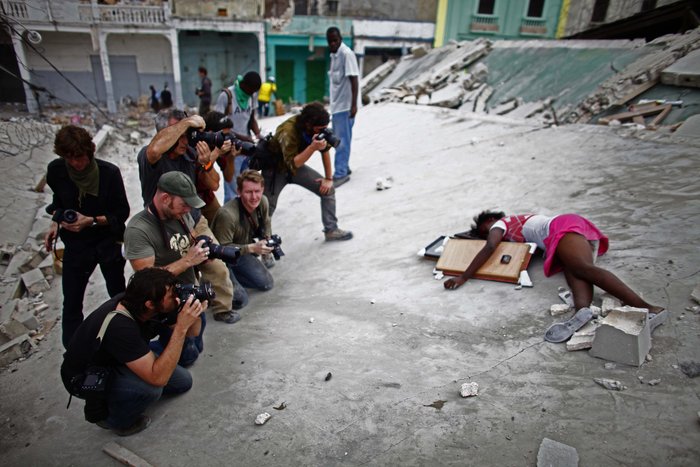January 2015

January 2015

Photojournalism can be like “trying to play Rachmaninoff while wearing boxing gloves,” as former photojournalist Simon Norfolk put it. One looks for the dramatic, the iconic, the universal, and in doing so the photographer then often simplifies the situation, removing it from a specific context that may help explain what the viewer will be seeing.
So it is in this photograph—the international press hovering like vultures next to the corpse. But what caused her death? What are they missing? Are they being callous? And what does the viewer need to know (but is not being told) about the circumstances surrounding this image?
The criticism of photojournalists as vultures is a familiar one. Kevin Carter, who won a Pulitzer Prize for his 1993 photograph of a struggling toddler trying to get to a feeding station in the Sudan with a vulture looking on, was widely branded as…


As both a phoTographer and a cop, I see this behavior all the time. It goes beyond documentation ...
While this image makes me sad it is an important picture because it reveals a larger truth. The w...
(Part 1 of 2)
This image raises many questions for me. The first relates to the maker of this im...
(Part 2 of 2)
The other question is about the role of race. Every one of the photographers appea...
I think this is a very sad picture for two reasons. The young girl in her pink skirt and shirt s...
I find this one hard to respond to with an image, as I have done with the rest of the months. It'...

News Agencies are a business and need to produce a very specific kind of imagery that will fit ne...

_-_Google_Art_Project.jpg?1421178798)
This is their job. They would have joined the Red Cross to save people in person, I believe, howe...
It's important to remember that this is not the first instance in the history of photojournalism ...
If you document something without supporting it than yes. But to capture the true essence of the...
The word vultures really captures this one. I wonder how many shots it took to get a 'good' one?


I'd like to echo Fred Ritchin's response that, "Given all the many digital tools at hand, it is a...

I feel like heartbreaking images serve the purpose of exposing the raw, real, gross realities of...
I don't think we can sum up the morals or lack of with this group photographers. We are required ...
What is sad to me about this image is that I do not flinch at it sight. I have never been close t...
My automatic answer is that photography crosses the line from documentation to exploitation when ...
Lets be clear on this aspect of crossing the line. In this picture the police crossed the line wh...
Hence the critique of documentary photography.
We as image makers have to decide if captur...